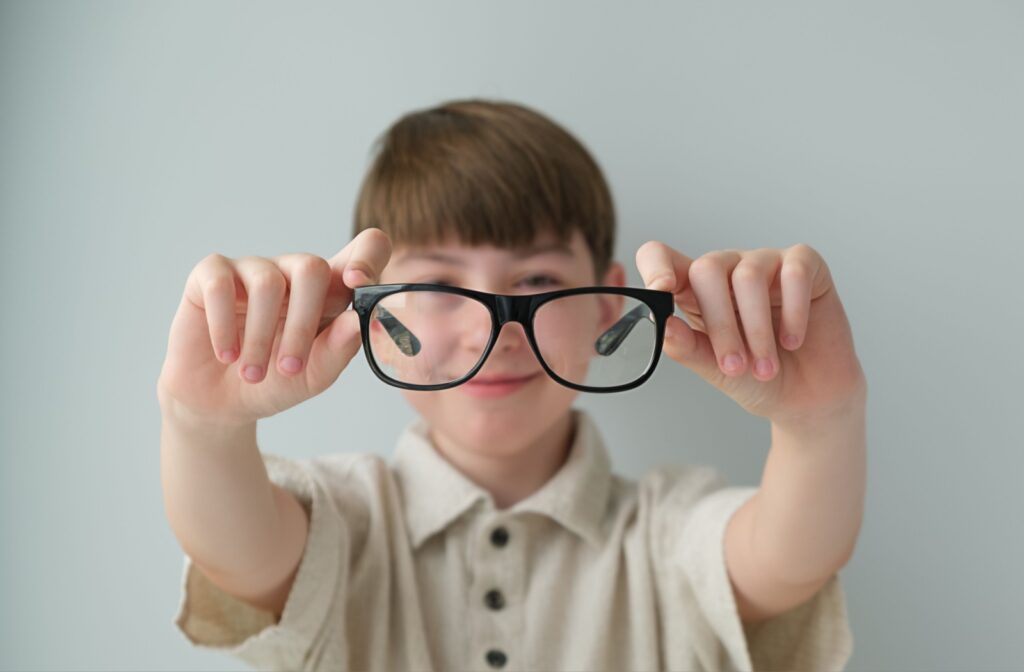Myopia, also known as nearsightedness, is a common vision condition that makes distant objects appear blurry. Many people first develop myopia in childhood, but the condition may continue to progress until early adulthood.
The main causes of worsening myopia include genetics, extended screen time, prolonged near work, limited outdoor time, and changes in eye shape during growth. Understanding what contributes to myopia progression can help you make choices that support your eye health or your child’s vision at every age.
Understanding Myopia
Myopia happens when the eye grows too long, causing light to focus in front of the retina instead of directly on it. This often begins in childhood and can progress rapidly as the eyes develop. For many people, myopia stabilizes once the eyes stop growing in early adulthood.
The Role of Genetics in Myopia Progression
Genetics is one of the strongest predictors of myopia. Children with one or both parents who are nearsighted have a higher risk of developing myopia and may experience faster progression. However, genetics isn’t the only factor, as environment and daily habits also play a big role in how myopia develops and worsens.
Screen Time and Eye Strain
Modern routines often involve a lot of screen time for school, work, and entertainment. Extended use of computers, tablets, and smartphones can strain the eyes and contribute to vision changes. Frequent near work, like reading or studying for long periods, adds stress on the eyes and can impact myopia progression.
To help reduce eye strain, follow the 20-20-20 rule: every 20 minutes, take a 20-second break and look at something at least 20 feet away. This simple habit supports healthier vision and may help slow myopia changes for some people.
The Importance of Outdoor Time
Research shows that spending time outdoors can help protect vision, especially in children. Natural light and focusing on distant objects balance the effects of near work and may slow how quickly myopia worsens.
Encourage outdoor play and regular breaks from screens whenever possible.
How Lifestyle Changes and Treatments Help

Healthy daily habits, like those discussed above, can help reduce the risk of a child’s myopia worsening. While lifestyle alone may not stop myopia completely, professional treatments can make a difference in correcting a person’s vision:
Common corrective options include:
- Prescription Glasses or Contact Lenses: Regular eye exams keep your prescription up to date and your vision clear.
- LASIK Surgery: While LASIK does not stop myopia from progressing during childhood, it can be an option for adults with stable prescriptions who want freedom from glasses or contact lenses. LASIK uses a laser to reshape the cornea and improve how light focuses on the retina, providing clear distance vision for many people.
Myopia Control Options
Myopia control lenses can go beyond basic vision correction by addressing factors that cause myopia to worsen in children.
Contact Lenses for Myopia Management:
MiSight contact lenses: These daily disposable contacts are clinically proven to slow myopia progression in children by providing clear vision and reducing eye elongation.
Orthokeratology (Ortho-k)
Ortho-k lenses are specially designed, rigid gas-permeable contacts that are worn overnight. While sleeping, these lenses gently reshape the surface of the cornea to temporarily correct vision. In the morning, they’re removed, leaving a child with clear vision throughout the day without the need for glasses or daytime contacts.
Ortho-k has also been shown to slow the progression of myopia in children. It’s a safe, effective option for many families looking for a non-surgical way to manage their child’s changing vision.
Atropine Drops
Atropine eye drops can help slow the progression of myopia in children. Used in low doses, atropine works by relaxing the eye’s focusing muscles. It doesn’t correct vision, so children still need glasses or contacts, but it may help reduce how quickly their nearsightedness worsens.
The drops are typically applied once a day and are generally well tolerated when prescribed by an eye care professional.
The Role of Regular Eye Exams
Regular eye exams help us track how myopia changes over time. Because myopia often develops in childhood and can continue to progress into adulthood, routine checkups help detect even small prescription changes. This makes it possible to update vision correction as needed and explore treatment options to help slow progression.
If you notice that your child’s glasses or contact lens prescription changes more often than before, it may be a sign that their myopia is advancing faster than usual. An eye care professional can help determine the cause and recommend ways to better manage it.
Managing Myopia Progression
Understanding what causes myopia to worsen is key to managing it. Genetics play a role, but habits like too much screen time, prolonged near work, and limited outdoor activity also contribute.
Simple changes like regular breaks during close-up tasks and more time outside can help slow progression. Combined with eye exams and options like specialized lenses or myopia control drops, these habits support long-term eye health. Keeping up with changes in vision makes it easier to choose the right approach to manage myopia early. We’re here to help you care for yours and your loved ones’ eyes at every stage of life. For more information about managing myopia, visit us at Pine Creek Vision Clinic in Colorado Springs and schedule your appointment today.



